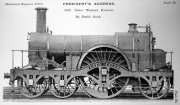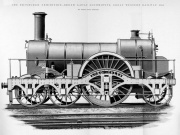Difference between revisions of "Daniel Gooch"
| Line 34: | Line 34: | ||
* Locomotive Assistant to [[Isambard Kingdom Brunel]] at [[Great Western Railway|GWR]] from 1837-64 | * Locomotive Assistant to [[Isambard Kingdom Brunel]] at [[Great Western Railway|GWR]] from 1837-64 | ||
* Laid out the original [[Swindon Works]] | * Laid out the original [[Swindon Works]] | ||
* Designed locomotives [[Firefly 1840]], [[Great Western 1846]] and heavy 4-4-0ST design for use west of Exeter. | * Designed locomotives [[Locomotive: Fire Fly|Firefly 1840]], [[Great Western 1846]] and heavy 4-4-0ST design for use west of Exeter. | ||
* Left GWR in 1864 to supervise laying of Atlantic cable but returned the next year as Chairman until his death | * Left GWR in 1864 to supervise laying of Atlantic cable but returned the next year as Chairman until his death | ||
Revision as of 11:58, 3 December 2013


Daniel Gooch (1816-1889) Locomotive Engineer and Manager.
1816 August 24th. Born in Bedlington the son of John Gooch of Bedlington and his wife Anna the daughter of Thomas Longridge of Newcastle.
As a young boy Gooch met George Stephenson and, as soon as he was old enough, he became an engineer at the the locomotive factory owned by Edward Pease and Robert Stephenson, in Newcastle-upon-Tyne.
Gooch went on to work in the Tredegar Ironworks foundry, in South Wales.
1837 Aged twenty-one, Gooch was appointed locomotive superintendent of the Great Western Railway and soon took advantage of the broad gauge favoured by Isambard Kingdom Brunel who was the the company's chief engineer, as his locomotives were much faster than those previously made. Gooch's locomotives could haul a large load at 60 mph (96 kph). Gooch designed 340 locomotives in all and these included the Great Western and the Iron Duke.
1864 Daniel Gooch worked for the Great Western Railway for twenty-seven years, but resigned in 1864 to concentrate on developing telegraphic communication. Gooch became chairman of the Telegraph Construction and Maintenance Co (Telcon) and director of the Anglo-American Telegraph Co.
1865 In the General Election Daniel Gooch became MP for Cricklade. Later that year, when the Great Western Railway got into financial difficulties, he agreed to resume chairmanship and the company's profits soon returned. As chairman of the company her fully supported Brunel's proposal to build the steamship, the Great Western.
1871 Living at Warwick Villas, Paddington (age 54 born Bedlington), Baronet and M.P.. With his wife Emily (age 29 born Norwood, Surrey) and their son Alfred W. (age 25 born Paddington), Civil Engineer. Also seven servants. [1]
1881 Staying at the Imperial Hotel, Malvern (age 64 born Bedlington), Baronet and M.P.. With his wife Emily (age 38 born Norwood, Surrey). [2]
1885 On leaving Parliament, Gooch continued as chairman of the Great Western Railway.
1886 Gooch pioneered the Severn Tunnel project.
1889 October 15th. Daniel Gooch died at Clewer Park, Berkshire, and was buried in St. Andrews Church, Clewer, near Windsor.
Best-known works
- Locomotive Assistant to Isambard Kingdom Brunel at GWR from 1837-64
- Laid out the original Swindon Works
- Designed locomotives Firefly 1840, Great Western 1846 and heavy 4-4-0ST design for use west of Exeter.
- Left GWR in 1864 to supervise laying of Atlantic cable but returned the next year as Chairman until his death
See Also
Sources of Information
- Chris de Winter Hebron, 50 Famous Railwaymen, 2005
- [1] Spartacus Educational




